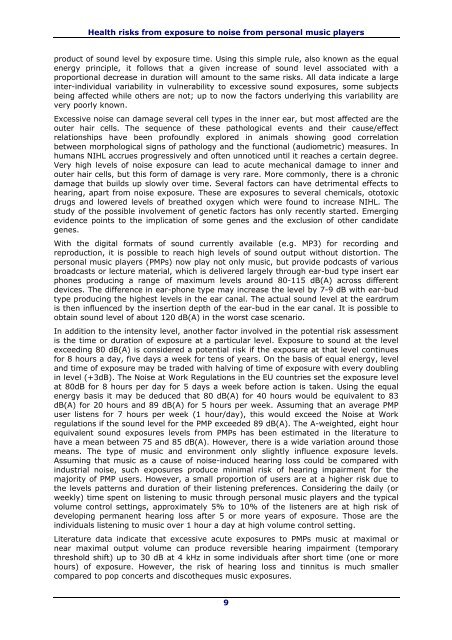Potential health risks of exposure to noise from personal music ...
Potential health risks of exposure to noise from personal music ...
Potential health risks of exposure to noise from personal music ...
Create successful ePaper yourself
Turn your PDF publications into a flip-book with our unique Google optimized e-Paper software.
Health <strong>risks</strong> <strong>from</strong> <strong>exposure</strong> <strong>to</strong> <strong>noise</strong> <strong>from</strong> <strong>personal</strong> <strong>music</strong> playersproduct <strong>of</strong> sound level by <strong>exposure</strong> time. Using this simple rule, also known as the equalenergy principle, it follows that a given increase <strong>of</strong> sound level associated with aproportional decrease in duration will amount <strong>to</strong> the same <strong>risks</strong>. All data indicate a largeinter-individual variability in vulnerability <strong>to</strong> excessive sound <strong>exposure</strong>s, some subjectsbeing affected while others are not; up <strong>to</strong> now the fac<strong>to</strong>rs underlying this variability arevery poorly known.Excessive <strong>noise</strong> can damage several cell types in the inner ear, but most affected are theouter hair cells. The sequence <strong>of</strong> these pathological events and their cause/effectrelationships have been pr<strong>of</strong>oundly explored in animals showing good correlationbetween morphological signs <strong>of</strong> pathology and the functional (audiometric) measures. Inhumans NIHL accrues progressively and <strong>of</strong>ten unnoticed until it reaches a certain degree.Very high levels <strong>of</strong> <strong>noise</strong> <strong>exposure</strong> can lead <strong>to</strong> acute mechanical damage <strong>to</strong> inner andouter hair cells, but this form <strong>of</strong> damage is very rare. More commonly, there is a chronicdamage that builds up slowly over time. Several fac<strong>to</strong>rs can have detrimental effects <strong>to</strong>hearing, apart <strong>from</strong> <strong>noise</strong> <strong>exposure</strong>. These are <strong>exposure</strong>s <strong>to</strong> several chemicals, o<strong>to</strong><strong>to</strong>xicdrugs and lowered levels <strong>of</strong> breathed oxygen which were found <strong>to</strong> increase NIHL. Thestudy <strong>of</strong> the possible involvement <strong>of</strong> genetic fac<strong>to</strong>rs has only recently started. Emergingevidence points <strong>to</strong> the implication <strong>of</strong> some genes and the exclusion <strong>of</strong> other candidategenes.With the digital formats <strong>of</strong> sound currently available (e.g. MP3) for recording andreproduction, it is possible <strong>to</strong> reach high levels <strong>of</strong> sound output without dis<strong>to</strong>rtion. The<strong>personal</strong> <strong>music</strong> players (PMPs) now play not only <strong>music</strong>, but provide podcasts <strong>of</strong> variousbroadcasts or lecture material, which is delivered largely through ear-bud type insert earphones producing a range <strong>of</strong> maximum levels around 80-115 dB(A) across differentdevices. The difference in ear-phone type may increase the level by 7-9 dB with ear-budtype producing the highest levels in the ear canal. The actual sound level at the eardrumis then influenced by the insertion depth <strong>of</strong> the ear-bud in the ear canal. It is possible <strong>to</strong>obtain sound level <strong>of</strong> about 120 dB(A) in the worst case scenario.In addition <strong>to</strong> the intensity level, another fac<strong>to</strong>r involved in the potential risk assessmentis the time or duration <strong>of</strong> <strong>exposure</strong> at a particular level. Exposure <strong>to</strong> sound at the levelexceeding 80 dB(A) is considered a potential risk if the <strong>exposure</strong> at that level continuesfor 8 hours a day, five days a week for tens <strong>of</strong> years. On the basis <strong>of</strong> equal energy, leveland time <strong>of</strong> <strong>exposure</strong> may be traded with halving <strong>of</strong> time <strong>of</strong> <strong>exposure</strong> with every doublingin level (+3dB). The Noise at Work Regulations in the EU countries set the <strong>exposure</strong> levelat 80dB for 8 hours per day for 5 days a week before action is taken. Using the equalenergy basis it may be deduced that 80 dB(A) for 40 hours would be equivalent <strong>to</strong> 83dB(A) for 20 hours and 89 dB(A) for 5 hours per week. Assuming that an average PMPuser listens for 7 hours per week (1 hour/day), this would exceed the Noise at Workregulations if the sound level for the PMP exceeded 89 dB(A). The A-weighted, eight hourequivalent sound <strong>exposure</strong>s levels <strong>from</strong> PMPs has been estimated in the literature <strong>to</strong>have a mean between 75 and 85 dB(A). However, there is a wide variation around thosemeans. The type <strong>of</strong> <strong>music</strong> and environment only slightly influence <strong>exposure</strong> levels.Assuming that <strong>music</strong> as a cause <strong>of</strong> <strong>noise</strong>-induced hearing loss could be compared withindustrial <strong>noise</strong>, such <strong>exposure</strong>s produce minimal risk <strong>of</strong> hearing impairment for themajority <strong>of</strong> PMP users. However, a small proportion <strong>of</strong> users are at a higher risk due <strong>to</strong>the levels patterns and duration <strong>of</strong> their listening preferences. Considering the daily (orweekly) time spent on listening <strong>to</strong> <strong>music</strong> through <strong>personal</strong> <strong>music</strong> players and the typicalvolume control settings, approximately 5% <strong>to</strong> 10% <strong>of</strong> the listeners are at high risk <strong>of</strong>developing permanent hearing loss after 5 or more years <strong>of</strong> <strong>exposure</strong>. Those are theindividuals listening <strong>to</strong> <strong>music</strong> over 1 hour a day at high volume control setting.Literature data indicate that excessive acute <strong>exposure</strong>s <strong>to</strong> PMPs <strong>music</strong> at maximal ornear maximal output volume can produce reversible hearing impairment (temporarythreshold shift) up <strong>to</strong> 30 dB at 4 kHz in some individuals after short time (one or morehours) <strong>of</strong> <strong>exposure</strong>. However, the risk <strong>of</strong> hearing loss and tinnitus is much smallercompared <strong>to</strong> pop concerts and discotheques <strong>music</strong> <strong>exposure</strong>s.9
















